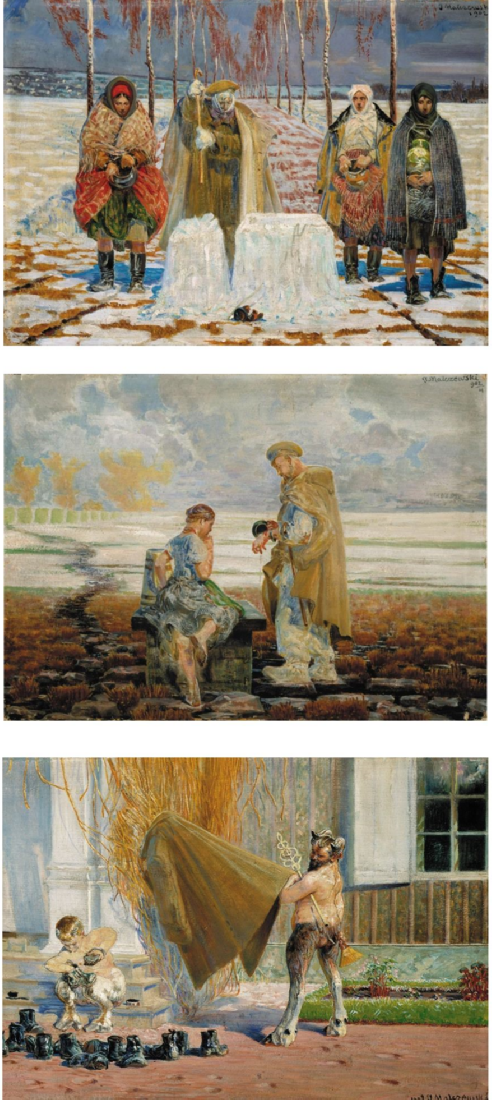Description:
Jack Malczewski (1854-1929) had a deep love for art and romantic literature, especially the poetry of Juliusz Słowacki, which he learned from his family home. He came from a noble, albeit not wealthy, family. His father Julian supported him on his path to a career in painting. The events of 1863, the January Uprising and subsequent repressions, had a profound impact on the young artist. His first teacher was Adolf Dygasiński. He spent his youth from 1867 to 1871 at his uncle Karczewski’s estate in Wielgiem. In 1873 he began studying at the Academy of Fine Arts in Krakow under the tutelage of Jan Matejko. He was a student of Władysław Łuszczkiewicz. He also studied at the École des Beaux-Arts in Paris. He traveled to Italy, Vienna, Munich, Greece, and Minor Asia. From 1896 to 1900 and 1910 to 1914 he was a professor at the Academy of Fine Arts in Krakow. From 1912 to 1914 he was its rector. He started with an idealizing realism, then naturalism, with the special theme of his works being the fate of exiles to Siberia and the inspiration of Juliusz Słowacki’s “Anhellim”. At the same time, fantastic and allegorical views began to appear in Malczewski’s work. After his father’s death in 1884, the recurring motif in Malczewski’s work was Thanatos – the god of death. After 1890 his art became thoroughly symbolic. Works manifesting the turn towards symbolism are: “Introduction” of 1890, “Melancholia” of 1890-1894, “The Vicious Circle” of 1895-1897. The artist tackled existential, historical, and artistic topics, weaving ancient and biblical motifs with native folklore and the Polish landscape, so essential to his works. Form, color, monumentality of representations and their expression became his hallmark.
Description of the painting:
The upper part of the triptych:
A landscape with winter fields covered in snow and an avenue of birches. In this setting, our story begins. At the crossing of the paths which the travellers had followed, a well was set up. Around it, four figures had gathered. Each with their own vessel had come to take the life-giving water. The man had his hands and face wrapped in a white cloth. It surely hides frostbite. His shoulders were covered with a Siberian coat. The traveller is returning from a distant journey. He is from none of the nearby villages. He is a stranger. The women watch helplessly as the old man, with a wooden stick, tries to break the ice. His strike resulted in the ice cracking, releasing the water that appears on the painting in the form of blue patches surrounding the feet of the gathered. As a result of the strike, the jug belonging to the man standing by the well slipped and broke.
The tool that the old man used – wooden and poor – is disproportionate to the effect of his work. How much strength can a tired exiled prisoner from Siberia have in his injured hands to break a lump as hard as a rock with a wooden stick? In the painting by Malczewski, this strength was enough. The only one, seemingly unable to act, achieved his desired goal. He reaches the source, but there is no vessel to draw water from it. The well is a motif often appearing in Jacek Malczewski’s work. However, in this case it is not a source of poisoned water, but a place of pilgrimage for people thirsty for hope and respite. In the harsh winter, even the water freezes. Only after a period of hard work can the needy quench their thirst. They have to break the numb ice.
Spring is coming. We find ourselves in front of a typical Polish manor house. Two satyrs are cleaning the items left to them. The younger faun perched on the steps of the porch and, holding a brush in his left hand, carefully polishes the black, mud-spattered shoes. Beside him, the handcuffs lie on the steps with the chain broken. The older satyr stands. He holds the folds of the cloak-scythe suspended on the branchless branches with his hand. He had literally swept it just now and shook it off. But now he has interrupted his work and with a mischievous smile on his face, he defiantly looks in our direction. Under his arm, he nonchalantly holds an object resembling a caduceus with two intertwined and intertwined snakes. It is called a herald’s staff, symbolizing his inviolability and having magical properties to alleviate all disputes.


